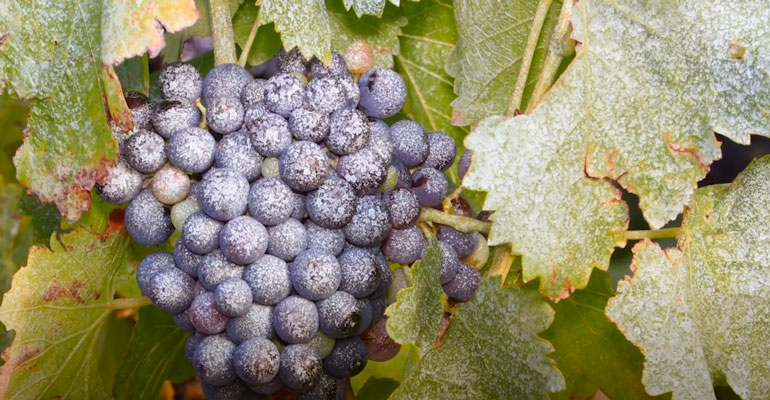June 12, 2020

Robots fitted with ultraviolet light lamps that roam vineyards at night are proving effective at killing powdery mildew, a devastating pathogen for many crops, including grapes.
Researchers at Cornell AgriTech in Geneva have partnered with SAGA Robotics in Norway to develop the first commercial robotic units, and the autonomous vehicle robots will appear on the market this year.
This spring, the researchers used two such robots to conduct field trials on Chardonnay grapes at two sites: Cornell AgriTech’s research vineyards in Geneva, N.Y., and at Anthony Road Wine Co. in Penn Yan, N.Y.
“For Chardonnay grapes, we’ve got effective suppression of powdery mildew over a period of two years, with treatments once a week,” says David Gadoury, senior research associate in the Department of Plant Pathology and Plant-Microbe Biology at Cornell Agritech, who leads the project.
The UV light technique is a breakthrough against powdery and downy mildew, which can adapt to chemical antifungal sprays in a single season, costing chemical companies hundreds of millions of dollars in development, along with environmental impacts.
“Everywhere grapes are grown, growers have to worry about powdery mildew,” says Lance Cadle-Davidson, a research plant pathologist in the Grape Genetics Research Unit at the USDA’s ARS unit in Geneva, a partner on the project.
“A typical grape grower will spray chemical fungicides for powdery mildew management between 10 and 15 times each year,” says Cadle-Davidson, who is also an adjunct assistant professor at Cornell University.
 ROBOTIC REMEDY: Autonomous robots fitted with UV lights can suppress powdery mildew. The key, though, is doing the treatments at night.
ROBOTIC REMEDY: Autonomous robots fitted with UV lights can suppress powdery mildew. The key, though, is doing the treatments at night.

Powdery mildews have co-evolved with the plants they attack over millions of years and often develop resistance to chemical treatments very quickly. But their evolution has also given them an Achilles heel: adaptation to natural cycles of light and dark.
How it works
UV light damages DNA though many organisms have developed biochemical defenses against this damage, which is triggered by blue light found in sunlight.
“What makes it possible for us to use UV to control these plant pathogens is we apply it at night,” Gadoury says. “At night, the pathogens don’t receive blue light and the repair mechanism isn’t working.”
The researchers use lamps that deliver a low dose of UV light, killing the pathogen without harming the plant. The technique has also proven effective against downy mildew and some insect pests.
In earlier trials, researchers used an array of UV lamps mounted on a tractor wagon. But the method is less practical due to the all-night labor required to treat a vineyard.
The robots are autonomous vehicles fitted with 8-foot-by-4-foot arrays.
“These machines will work seven nights a week, all night long,” Gadoury says.
“We’re right now on version 1.0 of this UV robot treatment, which applies the same dose of UV light to every vine regardless of whether it’s sick or healthy,” Cadle-Davidson says. “Our long-term vision is we’ll couple these detection and treatment approaches across the vineyard in an automated way.”
Source: Cornell AgriTech, which is solely responsible for the information provided and is wholly owned by the source. Informa Business Media and all its subsidiaries are not responsible for any of the content contained in this information asset.
You May Also Like




